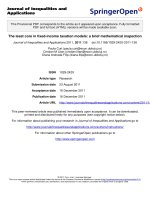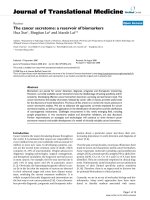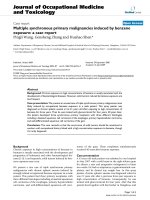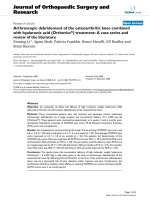báo cáo hóa học:" The versatile reverse flow sural artery neurocutaneous flap: A case series and review of literature" pot
Bạn đang xem bản rút gọn của tài liệu. Xem và tải ngay bản đầy đủ của tài liệu tại đây (377.01 KB, 6 trang )
BioMed Central
Page 1 of 6
(page number not for citation purposes)
Journal of Orthopaedic Surgery and
Research
Open Access
Research article
The versatile reverse flow sural artery neurocutaneous flap: A case
series and review of literature
Syed Kamran Ahmed, Boris Kwok Keung Fung*, Wing Yuk Ip, Margaret Fok
and Shew Ping Chow
Address: Division of Hand and Foot, Department of Orthopaedics and Traumatology, Queen Mary Hospital, University of Hong Kong, Pok Fu
Lam Road, Hong Kong, China
Email: Syed Kamran Ahmed - ; Boris Kwok Keung Fung* - ; Wing Yuk Ip - ;
Margaret Fok - ; Shew Ping Chow -
* Corresponding author
Abstract
Background: Reverse flow sural neurocutaneous flap has been utilized more frequently during the
past decade to cover vital structures around the foot and ankle area. The potential advantages are
the relatively constant blood supply, ease of elevation and preservation of major vascular trunks in
the leg. The potential disadvantages remain venous congestion, donor site morbidity and lack of
sensation.
Methods: This descriptive case series was conducted at Queen Mary Hospital, Hong Kong, from
1997 to 2003. Ten patients having undergone reverse flow sural neurocutaneous flap were
identified through medical records. There were six females (60%) and four males (40%), with an
average age of 59.8 years. The defects occurred as a result of trauma in five patients (50%), diabetic
ulcers in four (40%) and decubitus ulcer in one (10%) paraplegic patient. The defect site included
non weight bearing heel in four (40%), tendo Achilles in two (20%), distal tibia in two (20%), lateral
malleolus in one (10%) and medial aspect of the midfoot in one patient (10%). The maximum flap
size harvested was 14 × 6 cm. Preoperative doppler evaluation was performed in all patients to
identify perforators and modified plaster of paris boot was used in the post operative period. A
detailed questionnaire was developed addressing variables of interest.
Results: There was no flap failure. Venous congestion was encountered in one case. The donor
site was relatively unsightly but acceptable to all patients. The loss of sensation in the sural nerve
distribution was transient in all patients.
Conclusion: Reverse sural artery flap remains to be the workhorse flap to resurface the soft
tissue defects of the foot and ankle. Anastomosis of the sural nerve to the digital plantar nerve can
potentially solve the issue of lack of sensation in the flap especially when used for weight bearing
heel.
Published: 18 April 2008
Journal of Orthopaedic Surgery and Research 2008, 3:15 doi:10.1186/1749-799X-3-15
Received: 5 October 2007
Accepted: 18 April 2008
This article is available from: />© 2008 Ahmed et al; licensee BioMed Central Ltd.
This is an Open Access article distributed under the terms of the Creative Commons Attribution License ( />),
which permits unrestricted use, distribution, and reproduction in any medium, provided the original work is properly cited.
Journal of Orthopaedic Surgery and Research 2008, 3:15 />Page 2 of 6
(page number not for citation purposes)
Background
Soft tissue defects around the foot and ankle region often
present an awkward problem to the orthopaedic surgeons.
Tendons and bones are frequently exposed after trauma
because of the thinness of the subcutaneous tissue. Tradi-
tionally, local flaps were used for resurfacing but their use
is limited by their size and arc of rotation. Reverse flow
flaps such as anterior tibial artery flap and posterior tibial
artery flap require the sacrifice of major arteries. Free flap
is currently the treatment of choice for large soft tissue
defects of the distal extremity and it solves the problem of
donor site morbidity in the immediate vicinity of the flap.
It is however a technically demanding procedure for sur-
geons with less microsurgical experience. Furthermore in
a few cases of trauma with damaged or occluded major
vessels, where a free flap may be potentially hazardous,
the reverse sural artery flap can prove to be one of the few
safe options for soft tissue coverage [1]. The accompany-
ing arteries of the lesser saphenous vein and sural nerve
have been utilized with success for harvest of reverse flow
sural flap [2]. The sural nerve remains the anatomic land-
mark for the inclusion of vessels in pedicle of the flap. The
sural artery reverse flow flap is nourished by the lower-
most perforating branch of the peroneal artery. Since the
introduction of this flap by Masquelet [3] in 1992, it has
become one of the favourite among reconstructive sur-
geons. It is the flap of first choice in our centre. In the
present report, the results of reverse flow sural neurocuta-
neous flaps done at our centre is presented along with
some thought provoking ideas for the future.
Methods
This descriptive case series was conducted between 1997
and 2003, at Queen Mary Hospital, The University of
Hong Kong, Division of Hand Surgery, Department of
Orthopaedics and Traumatology. It is a tertiary care centre
for cases requiring microsurgery of the extremities. From
1997 to 2003, we performed ten reverse sural neurocuta-
neous flaps on ten patients (See Table 1). The age ranged
from 19 to 85 years, with a mean age of 59.8 years. There
were six females (60%) and four male patients (40%). The
soft tissue defects were located on non weight bearing heel
in four patients (40%), tendo Achilles in two patients
(20%), distal tibia in two patients (20%), lateral malleo-
lus in one patient (10%) and medial aspect of the midfoot
in one patient (10%). No patient underwent resurfacing
of the weight bearing heel. The minimum and maximum
flap size harvested (length × breadth in cm.) was 5 × 4 and
14 × 6 respectively. A midline cuff of gastrocnemius was
included in one of the flap harvested from the proximal
calf area. All benefits and disadvantages of the operation
were discussed with the patient before the operation,
including the sensory loss in the distribution of the sural
nerve. A detailed questionnaire was developed using vari-
ables of interest.
Preoperative evaluation included identification of the site
of peroneal perforators above the lateral malleolus using
Doppler flow meter. Two or three perforators were identi-
fied above the lateral malleolus. The pivot point of the
pedicle was chosen according to the need of distal cover-
age, but it was limited by the lower most perforator, about
05 cm. from the tip of the lateral malleolus.
The skin was incised close to the midline, so as to be sure
to include the short saphenous vein in the pedicle in all
patients. The skin flap was then elevated with the deep fas-
cia. The pedicle was kept wide, around 03 to 04 cm. in
diameter. The flap was rotated 180 degrees through an
open tunnel in all but one patient. Split thickness skin
graft was used to cover the exposed pedicle in all but one
patient. All patients were kept in the 'modified plaster of
paris boot' in the post operative period (Figure 1).
Results (Also see Table 1)
Survival
All flaps survived.
Venous congestion
Only one flap developed mild venous congestion in the
early post operative period, which resolved with foot ele-
vation.
Table 1: Patients' data. Demographic features, etiology, defect site and size, comorbids, flap type and outcome
Sex Age Etiology Site of defect Flap size (cm) Comorbids Flap type Complications
F 72 Ulcer Medial aspect of mid foot 9 × 7 DM Sural Mild venous congestion
M 74 Pressure sore Lateral malleolus 5 × 4 Paraplegia Sural
F 68 Ulcer NWB heel 8 × 6 DM Sural
F 62 Trauma NWB heel and medial malleolus 11 × 7 Sural
M 48 Trauma Tendoachilles 8 × 6 Sural
F 53 Trauma Shin 8 × 6 Sural
F 19 Trauma NWB heel 14 × 6 Sural
M 52 Trauma Distal tibia 9 × 7 Sural
F 85 Ulcer Achilles tendon 7 × 4 PVD, DM Sural
M 65 Ulcer Posterior heel 8 × 5 DM Sural
Journal of Orthopaedic Surgery and Research 2008, 3:15 />Page 3 of 6
(page number not for citation purposes)
Weight bearing problems
None of our patients had resurfacing to the weight bearing
part of the heel. There was no interference with walking.
Donor and recipient site appearance
The donor site had no complications except for the rela-
tively unsightly scar. It was acceptable to all patients. All
patients were satisfied with the cosmesis of the recipient
site.
Numbness/Neuroma
Transient numbness along the sural nerve distribution
was experienced by the patients. It resolved in all patients
by three months. No painful neuroma developed as we
routinely buried the nerve stump in the deep muscular
plane.
Need for debulking of the flap
No patients required debulking for cosmetic reasons or
shoe wear problems.
Case reports
Case report 1 (Figures 2A and 2B)
72 years diabetic lady suffering from ulcer on the dorso-
medial aspect of the right midfoot was successfully cov-
ered using the reverse sural flap from proximal calf area
with the modification of inclusion of the midline cuff of
gastrocnemius, as described by Al Qattan MM [4].
Case report 2 (Figures 3A, 3B, 4A, 4B and 4C)
19 years lady sustained road traffic accident resulting in
skin necrosis of the posterior aspect of the left heel.
Reverse sural flap size 14 × 6 cm. was used to successfully
cover the defect.
Discussion
The results of this study show that the reverse sural neuro-
cutaneous flap is an effective method to resurface soft tis-
sue defects around the foot and ankle region.
We would recommend some measures that we adopted in
our cases and which have been advised in the literature to
ensure safe flap elevation and improve the venous conges-
tion of the flap, hence decrease the risk of failure.
1) Preoperative identification of the peroneal artery perfo-
rators by Doppler should be performed and the peropera-
tive search for a perforator should be avoided which can
be potentially dangerous [1].
2) A 'modified plaster of paris boot' (Figure 1), that we
describe in our cases can be used to avoid pressure on the
pedicle in the postoperative period. This helps the
patients to remain supine, allows assessment of the flap
circulation and assists in the elevation of the foot to
relieve venous congestion.
3) The pedicle should be kept wide (3 to 4 cm.) [1,3] and
skin grafting should be done on the pedicle if the subcu-
taneous tunnel becomes tight and impairs circulation. In
our series, in nine out of ten patients the pedicle was
passed through an open tunnel and skin grafted.
Although skin grafting added slightly to the donor site
morbidity, it prevented pressure on the pedicle in the post
operative period.
4) The lesser saphenous vein should be included in the
pedicle in all cases [2].
5) There are a few studies in which this flap is used to
cover defects in the distal part of the foot by slight modi-
fication of the flap design, by inclusion of the midline cuff
POP bootFigure 1
POP boot. A 'modified plaster of paris boot' is designed to
make sure that there is no pressure on the flap pedicle even
if the patient is lying supine in bed. One can appreciate the
built in walls of the boot on the posterior aspect, with the
flap visible from within them.
Journal of Orthopaedic Surgery and Research 2008, 3:15 />Page 4 of 6
(page number not for citation purposes)
of gastrocnemius muscle, in flaps harvested from proxi-
mal calf area [4]. We performed one flap in this manner to
cover the medial aspect of the midfoot in an old lady with
diabetic ulcer (Figure 2A and 2B). We postulate that the
whole skin of the posterior calf can be harvested without
any major problem. Sural neurofasciocutaneous flaps as
large as 17 × 16 cm. have been reported [5].
6) Leech therapy can also be used to decrease venous con-
gestion [6]. We did not require the use of leech therapy in
cases of reverse sural neurocutaneous flaps but did found
it of use in a reverse flow saphenous neurocutaneous flap.
Anastomosis with one of the donor veins from the foot
may also be an alternative, but we do not see the need for
this intervention at the moment.
The vascular anatomy and clinical application of the
reverse sural neurocutaneous flap has been well studied
[2,7-10]. The artery existed as an axial pattern vessel in
only 50 percent of our patients.
Self limiting numbness in the distribution of sural nerve
is not a major concern. The patients should be counselled
preoperatively and the problem is usually resolved on an
average in three months in all patients. To avoid a painful
neuroma, the nerve stump needs to be buried in the deep
muscular plane.
Donor site morbidity was minimal in our patients. Unaes-
thetic donor site, perhaps, may be a major concern to the
young female patients. It can potentially be avoided by
using an adipofascial flap, rather than harvesting skin
island in larger flaps.
Future Concern
Based on the sensate character and same quality skin,
medial plantar flap has been proposed to be superior for
heel coverage over sural artery reverse flow flaps [11,12].
However no substantial clinical or laboratory data is avail-
able for reinnervating the reverse sural artery flaps.
Reverse flow homodigital island flaps for finger tip inju-
ries have been rendered sensate by including a segment of
palmar digital nerve in the flap design and anastomosing
it to the opposite side digital nerve [13-15].
Based on the above observations we postulate end to side
anastomosis of the sural nerve to a plantar digital nerve,
in order to provide sensory reinnervation to the flap espe-
cially in cases of weight bearing heel reconstruction.
Conclusion
We highly recommend this flap to resurface soft tissue
defects in the foot and ankle region because it is easy to
harvest, reliable and can be used in patients with periph-
eral vessel disease and trauma patients with damaged
major vessels [1].
A – CR. 1, flap elevationFigure 2
A – CR. 1, flap elevation. 72 years lady was suffering from ulcer on dorso medial aspect of midfoot as a result of long stand-
ing diabetes mellitus leading to peripheral neuropathy. Sural artery flap was utilized; its elevation is seen from the proximal
aspect of the posterior calf area, modified by the inclusion of midline gastrocnemius muscle cuff around the sural pedicle. B –
CR. 1, Post op. Adequate coverage seen in the immediate post operative period. The pedicle was kept wide and not passed
through subcutaneous tunnel. It required split thickness skin grafting for coverage. The flap developed mild distal congestion
which resolved spontaneously with foot elevation without any problems.
Journal of Orthopaedic Surgery and Research 2008, 3:15 />Page 5 of 6
(page number not for citation purposes)
A – CR. 2, pre opFigure 3
A – CR. 2, pre op. 19 years lady suffered road traffic accident resulting in skin necrosis of the posterior aspect of the heel. B
– CR. 2, post debrima. After debridement, area of skin loss can be seen, optimal for flap coverage.
A – CR. 2, flap markingFigure 4
A – CR. 2, flap marking. The sural artery neurocutaneous flap is marked on the skin with dimensions, 14 × 6 cm. B – CR. 2
– flap rotation. The reverse flow sural artery neurocutaneous flap is being rotaed through an arc 180 degrees on its pedicle.
C – CR. 2 – outcome. The flap inset into the defect after rotation with excellent coverage.
Publish with BioMed Central and every
scientist can read your work free of charge
"BioMed Central will be the most significant development for
disseminating the results of biomedical research in our lifetime."
Sir Paul Nurse, Cancer Research UK
Your research papers will be:
available free of charge to the entire biomedical community
peer reviewed and published immediately upon acceptance
cited in PubMed and archived on PubMed Central
yours — you keep the copyright
Submit your manuscript here:
/>BioMedcentral
Journal of Orthopaedic Surgery and Research 2008, 3:15 />Page 6 of 6
(page number not for citation purposes)
List of abbreviations
POP: plaster of paris, CR: case report, pre op: pre opera-
tive, post op: post operative, debrima: debridement,
NWB: non weight bearing, F: female, M: male, PVD:
peripheral vascular disease, DM: diabetes mellitus, cm:
centimetres
Competing interests
The authors declare that they have no competing interests.
Authors' contributions
SKA carried out patient follow up, concept design, data
collection, literature search, manuscript writing and criti-
cal revision. BKKF carried out surgery, patient follow up,
concept design, manuscript writing and literature search.
WYI carried out surgery, patient follow up, literature
search. MF carried out patient follow up, data collection.
SPC carried out surgery, review and final approval of the
manuscript. All authors read and approved the final man-
uscript.
Acknowledgements
We acknowledge the help of Mr. Henry Leung in the process of formatting
figures and table according to the Journal's guidelines.
As no individual patient's identity is revealed by the photographs, verbal
consent for publication was obtained from the patient or their relative,
either telephonic or on a follow up visit.
References
1. Hsieh CH, Liang CC, Kueh NS, Tsai HH, Jeng SF: Distally based
sural island flap for the reconstruction of a large soft tissue
defect in an open tibial fracture with occluded anterior and
posterior tibial arteries-a case report. Br J Plast Surg 2005,
58:112-115.
2. Nakajima H, Imanishi N, Fukuzumi S, Minabe T, Fukui Y, Miyasaka T,
Kodama T, Aiso S, Fujino T: Accompanying arteries of the lesser
saphenous vein and sural nerve: anatomic study and its clin-
ical applications. Plast Reconstr Surg 1999, 103(1):104-120.
3. Masquelet AC, Romana MC, Wolf G: Skin island flaps supplied by
the vascular axis of the sensitive superficial nerves: anatomic
study and clinical experience in the leg. Plast Reconstr Surg 1992,
89:1115-1121.
4. Al Qattan MM: A modified technique for harvesting the
reverse sural artery flap from the upper part of the leg: inclu-
sion of gastrocnemius muscle 'cuff' around the sural pedicle.
Ann Plast Surg 2001, 47(3):269-274.
5. Ayyappan T, Chadha A: Super sural neurofasciocutaneous flaps
in acute traumatic heel reconstructions. Plast Reconstr Surg
2002, 109:2307-2313.
6. Gideroglu K, Yildrim S, Akan M, Akoz T: Immediate use of medic-
inal leeches to salvage venous congested reverse pedicled
neurocutaneous flaps. Scand J Plast Reconstr Surg Hand Surg 2003,
37(5):277-282.
7. Imanishi N, Nakajima H, Fukuzumi S, Aiso S: Venous drainage of
the distally based lesser saphenous-sural veno-neuroadipo-
fascial pedicled fasciocutaneous flap: A radiographic per-
fusion study. Plast Reconstr Surg 1999, 103(2):494-498.
8. Fraccalvieri M, Verna G, Dolcet M, Fava R, Rivarossa A, Robotti E,
Bruschi S: The distally based superficial sural flap: our experi-
ence in reconstructing the lower leg and foot. Ann Plast Surg
2000, 45(2):132-139.
9. Jeng SF, Wei FC, Kuo YR: Salvage of the distal foot using the dis-
tally based sural island flap. Ann Plast Surg 1999, 43(5):499-505.
10. Mak KH: Distally based sural neurocutaneous flaps for ankle
and heel ulcers. Hong Kong Med J 2001, 7(3):291-295.
11. Rashid M, Hussain SS, Aslam R, Illahi I: A comparison of two fasci-
ocutaneous flaps in the reconstruction of defects of the
weight bearing heel. J Coll Physicians Surg Pak 2003, 13(4):216-218.
12. Leung PC, Hung LK, Leung KS: Use of the medial plantar flap in
soft tissue replacement around the heel region. Foot Ankle
1988, 8(6):327-30.
13. Brunelli F, Mathoulin C: Presentation of a new homodigital
countercurrent sensitive island flap. Ann Chir Main Memb Super
1991, 10(1):48-53.
14. Endo T, Kojima T, Hirase Y: Vascular anatomy of the finger dor-
sum and a new idea for coverage of the finger pulp defect
that restores sensation. J Hand Surg [Am] 1992, 17(5):927-932.
15. Lai CS, Lin SD, Chou CK, Tsai CW: Innervated reverse digital
artery flap through bilateral neurorraphy for pulp defects. Br
J Plast Surg 1993, 46(6):483-488.









